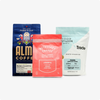- Home›
- Great for Pour Over›
Great for Pour Over

This collection of unique coffees is filled with the kind of bright, clean flavors you’ll enjoy brewing with your favorite pour over device.

FAQS
Coffee Talk
At Trade, we bring together top, independent roasters from towns across the USA—places you’d love if you lived nearby—and curate the best coffees for folks everywhere to enjoy. Then, we match you with options you’ll love—recommending specific coffees based on what you like or would like to try. Whether you’re a stickler for consistency or an adventurist who likes to mix it up, we’ll help you discover coffees that bring out the best in your mornings, afternoons, and every moment in between.
We seek out the best local independent coffee roasters from coast to coast, and we're proud to partner with 50+ of them. They're the places you'd love to have nearby and the people you'd want as friends - pouring passion into every detail, crafting coffee the right way, and developing lasting partnerships along the coffee supply chain to build an equitable global community. You can learn more about Trade’s specialty roasters here.
We really truly do! Since we work with over 50 different roasters across the country, we know we'll be able to match you with incredible coffees you'll enjoy with each order. It's all in the spirit of discovering something new without worry.
That's where we're happy to help make things a bit easier. If you're not already a subscriber, feel free to take our quiz to see what we'd recommend for your taste.
If you're already a subscriber, then you know our algorithm takes care to match you with amazing coffees for every order. However, if you're still looking for something new and don't quite know where to start, you should check out our Trade Secrets program. Each week there's a new, limited-release that's available for a short time. These coffees are not only an adventure when it comes to taste, but also have a story to tell.
We currently ship within the United States using USPS. We are able to ship to all 50 US states, including Alaska & Hawaii. At this time we do not ship to APO/FPO/DPO addresses, Puerto Rico, Canada, or internationally. We do not ship to freight forwarding addresses.





